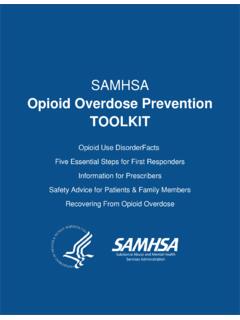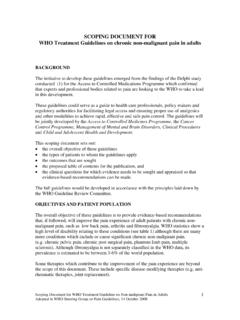Transcription of Palliative care: Issues and challenges
1 Palliative care : Issues and challengesSue Lucas1. BackgroundMore than 50 million people die throughout the world each year. The majority four fifths of these deaths are in developing countries. HIV has increased thenumber of deaths, with 3 million people dying in 2000, million in sub-SaharanAfrica. Even where advanced therapies are available, length of life may bereduced for those with HIV. In addition, advanced HIV illness is associated withsevere pain. People living with HIV in developing countries can therefore expect ashorter life span, and their death is likely to be unnecessarily painful for the dying is not new, and different cultures have different approaches tohelping people at the end of their lives.
2 Palliative care is based on a modeldeveloped in response to the needs of cancer patients by the hospice movementin the UK. It aims to make death a pain-free process which includes support,comfort and relief of symptoms, making it possible for people to die with people with HIV, Palliative care is an essential part of treatment , not only asdeath approaches but also through the treatment of potentially fatal symptoms ofopportunistic infections. Such treatment , while not curative, neverthelessprolongs life for considerable periods of time and restores quality of HIV epidemic has led to increased efforts to provide care and support forpeople in their homes. While this has been a great step towards the care thatpeople need, many home care projects are unable to provide the pain relief andtreatment of symptoms that are needed to prolong life and ease dying and investment is needed to ensure that when advanced treatment is no longereffective, or when it is inaccessible for any reason, people can have access tosymptomatic treatment and pain relief.
3 The obstacles are political, financial andthe lack of understanding and training in the Palliative care approach. As withother models of health care , HIV brings its own particular challenges to theconcept and implementation of Palliative What is Palliative CareThe aim of Palliative care is to provide the best possible quality of life both forpeople approaching the end of life and for their families and carers. It is a holisticapproach to care and support, and takes into account emotional, psychologicaland spiritual needs as well as physical needs. Pain control is central to theconcept of Palliative care . Freedom from pain allows people to come to terms withtheir approaching death and enables them to make arrangements for the futureof others who depend on them, as well as to live as fully as possible for as longas defines Palliative care as an approach that: Affirms life and regards death as a normal process.
4 Does not hasten or postpone death. Provides relief from pain and other symptoms. Offers a support system to help patients live as actively as possible rightup to their death. Integrates psychological and spiritual care . Provides a wider support to help the family cope during the patient sillness and their own bereavement after for caregivers is an essential part of Palliative care , whether they befamily members or professional carers. For professional carers, an integral part ofproviding Palliative care is to work with families and friends to ensure control is central to Palliative care , and presents challenges in itself. Theanalgesia ladder, as developed by WHO, includes three steps:Step 1:Aspirin or 2:Codeine or dihydrocodeine, with or without non-steroidal or antiinflammatory drugs such as ibuprofen or 3:Morphine, with or without co-analgesia, and with or without steroid anti-inflammatory drugs.
5 Other strong opioid analgesics include pethidin Palliative care includes access to these drugs, some of which arecontrolled through restrictive legislation, and access to authorised staff competentin using them. Training, policy change and change in attitudes towards the use ofsuch drugs is an essential part of developing access to Palliative care . Cannabishas also been found to be a helpful in symptom control for people with HIV, andsome people living with HIV/AIDS (PLWHA) have argued for it to be made moreeasily available. It is, however, very strictly controlled in most Present modelsThere are existing models of Palliative care approaches in developing of these were initially developed to respond to the needs of people withcancer and have expanded to include people with HIV, and others which havedeveloped Palliative care processes as part of their response to the HIV face their own particular challenges and there are lessons to be learnt fromeach both for each other and for meeting the challenges of increasing the scaleof access to such Africa, the Hospice movement has developed and is expanding a few countries,including South Africa, Uganda and Zimbabwe.
6 The principles of the Hospicemovement, established initially in the UK, were developed in these projects totreat cancer patients, and are now working also with people with HIV. Thisincludes home care , treatment to relieve pain and psychological and spiritualsupport. Some of these, such as Hospice Uganda and Hospice South Africa(HASA) are able to provide training in Palliative care to help increase the localcapacity in implement Palliative care projects. These Hospices, in common withother smaller hospice projects are caring for people with HIV as well as those withcancer. This means understanding the Issues peculiar to HIV, including stigmaand discrimination and the importance of confidentiality, and the need to set upor link into other initiatives providing voluntary testing and projects such as TASO, in Uganda, The Mildmay Centre for AIDS Palliativecare in Uganda, the Ministry of Health/NGO Home care Programme GovernmentNGO in Cambodia, and the Ndola Diocese Home care programme in Zambia havebeen established in response to the HIV epidemic.
7 Links between the two modelsare necessary to ensure that optimum care is made available to those who needit, and that the experiences from different angles are shared. Good referralsystems, especially where projects focus on different aspects of Palliative care ,are also Public policy issuesPalliative care , whether for people with HIV or for others with chronic illness, is anessential part of any health care system. WHO has identified three foundationmeasures to scaling up the provision of such care :1. Development of a national policy. Palliative care is not recognized in manygovernment plans. For example, Uganda is the only country in sub-Saharan Africa that has adopted WHO s foundation measures forestablishing a Palliative care service.
8 While a handful of other countries inthe region have some provision for Palliative care , this is provided outsidethe government health service. Advocacy for provision of Palliative care aspart of the essential health service system by the government will be amove towards ensuring some budget allocation for provision of care forthose with chromic Training for health workers and public education. Understanding of whatpalliative is, and training to carry it out, is necessary for policy makers,health professionals and families. For HIV, such training needs to be linkedto training on areas specific to HIV such as transmission and control oftransmission, Issues of stigma and discrimination, and respect Pain control.
9 Pain is as important in HIV infection as it is in cancer. Somestudies have shown that pain is reported as a primary symptom by morethan half of people with HIV. In many countries, this will require trainingand awareness raising among health professionals, and advocacy tochange laws to make effective pain relief response to HIV has been led by NGOs, and often by small community basedNGOs with very limited resources. As the health care services have been erodedby the impact of the HIV epidemic, the response has been in many places toestablish home care schemes. These are often seriously under-resourced, andwhile there is no doubt that they help to ease suffering (and if nothing else isavailable can provide accompaniment and spiritual comfort), it is important thathome care schemes are helped and upgraded.
10 Many have a great potential,through partnerships and working with governments, to provide a platform fromwhich proper provision of Palliative care can be started. But it is also importantthat home care , in the sense of providing some minimal level of support, is notconfused with provision of Palliative with other aspects of HIV treatment , little research or experience is availableon Palliative care for children with HIV. The principles of Palliative care apply toboth children and adults pain and symptom relief is as essential for children asit is for care is not an alternative to other models of health care . It is not incompetition with efforts to provide antiretroviral and other advanced therapies,nor is it a poor relative to be implemented where such therapies are currentlyinaccessible.












